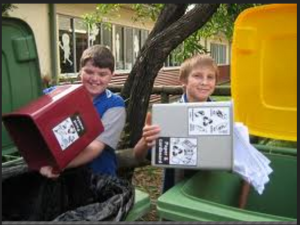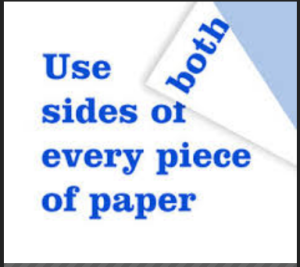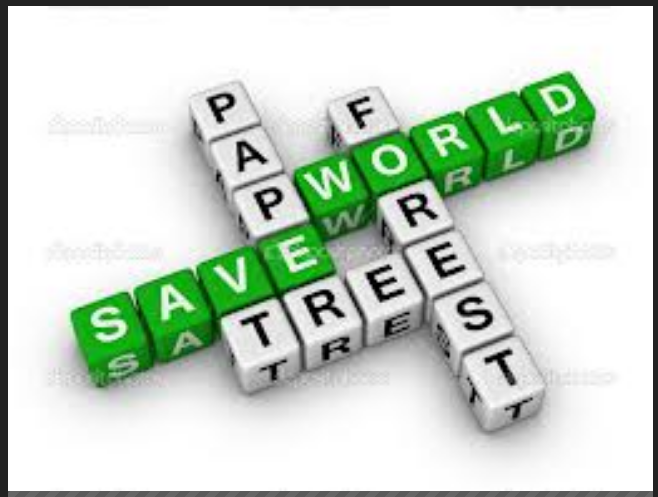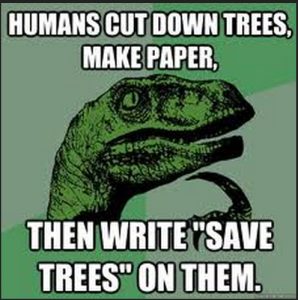The environmental studies class got over. It was about waste production , disposal and management. It talked about the different kinds and sources of waste and it’s management.
After that the teacher them a group project on waste management. It was a soft-board decorating project. The one with lots of cuttings and mountains of paper. An individual file was to accompany each student. ‘Remember, more illustration. Better presentation. Be creative.’ That’s what she said.
What the teacher had just given them as an interactive learning activity was almost contrasting with the lesson she had just taken in class. It dealt with the 3 R s :Reduce, Recycle and Reuse. She had asked them to not waste paper, water, electricity, fuel and other such resources. Yet, the project would ultimately cause much more waste and resource consumption than all the waste management than they could do. Worse is, the consumption and waste production is indirect and subtle. Hard to pin-point.
Waste is generated all the time. Sometimes, it can be avoided and sometimes not. However with the recent anti-green ways of life that we find comforting and almost progressive, a lot of avoidable waste is generated. Think schools. There are dozens of notebooks. There are practice, class work, home work and test notebooks. Mostly, as the year ends, more than half the test notebooks are clean and without writing. Then, the notebook is simply thrown away. So many clean white pages – wasted.
I am not condemning the ways of the education system here. I am simply putting forth the suggestion that maybe , children can be taught things even without the extravagance of a dozen kinds of paper and print outs and punched sheets and files.
Here are some ideas that crossed my mind, to remedy this.
- Instead of using different notebooks for homework and practice, only one can be used. Who does both of them religiously anyway?
- Instead of a separate test notebook, sheets can be used to answer in tests. It reduces both weight and waste.The test sheets can be used from the old notebooks from the previous year.
- For file projects, the same file can be used over and over again. If it is a paperback one, the cover can be changed. If it is a plastic one, the label can be changed. This way, both money and waste is reduced as we reuse the same article.
- Instead of those thick punched sheets, simple old notebook sheets can be used. In any case, assignment files are marked on information, not the kind of glossy paper used.
- Instead of all such flowery papered presentations, group interaction projects could be made more hands-on. For example, the students may be given a project on collecting trash paper (newspaper, used office paper, etc . ) and selling it to the waste paper mart, or , in India, the ‘raddiwallah’. The students can interact, co-operate, lead and learn. They could get first-hand experience into the various stages of waste management and how it changes hands from the producer to the small dealer to the big dealer to the recycling units and back. The proceedings of the sale can go into buying rough stationery, etc.
- Reusing books. An exchange unit can be set up in schools wherein the passing class can deposit their textbooks while the incoming students of the class can reuse these books. It saves both money and paper in the form of new textbooks.
- A paper recycling unit can be set up in schools. All the office paper waste, classroom paper refuse can be shredded and recycled by making a paper slurry and new handmade paper. I have done it in school. It is very easy , engaging and immensely helpful. The recycled paper can be patterned and colored to make greeting cards, etc.
- The school waste bins should be different for different types of waste. All the paper waste can be segregated and then sent for recycling.

- Go digital. School general notices can always be put up on the official website than sending notes of paper to parents.
- If one side of a paper is used, the other blank side can be used for rough work.

- The CBSE Board has begun a program called ‘Tod Phod Jod’ that is an initiative to nurture the young creative minds. It involves leaving the students in a room full of random waste materials from the school premises. They can pick up any of the things and make their own article, exercising their creativity. I think it is a brilliant initiative that can be implemented throughout the education system.
- Encourage the use of recycled materials for covering textbooks and notebooks.
- Encourage the use of recycled materials for covering textbooks and notebooks.
- Encourage the use of recyclable material as carry bags too.
- The notebooks can be consciously bought which are made of sustainable forests grown for paper pulp.
- Involving students in afforestation drives.
- Awareness campaigns.
- The students should be used to this way of life with minimal waste production as soon as they enter enter kindergarten so that it does not become an additional effort to go green but comes effortlessly and naturally
- All the reduction and re-utilization is always easier than recycling.
Many of the steps are difficult to implement but not impossible. Every sheet of paper marks the murder of a tree. So, each piece of paper is valuable. Every small piece of paper counts. Including that one that you make paper planes with out of boredom. Yes, go recycle that !


Leave a Reply